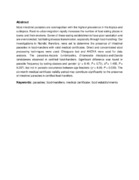Prevalence of intestinal parasitic infections in certified food-handlers working in food establishments in the City of Nairobi, Kenya
Date
2012-03Author
Kamau, Paul
Aloo-Obudho, Peninah
Kabiru, Ephantus
Ombacho, Kepha
Langat, Bernard
Mucheru, Obadiah
Ireri, Laban
Metadata
Show full item recordAbstract
Most intestinal parasites are cosmopolitan with the highest prevalence in the tropics and subtopics. Rural-to-urban migration rapidly increases the number of food eating places in towns and their environs. Some of these eating estabishments have poor sanitation and are overcrowded, facilitating disease transmission, especially through food-handling. Our investigations in Nairobi, therefore, were set to determine the presence of intestinal parasites in food-handlers with valid medical certificates. Direct and concentrated stool processing techniques were used. Chisquare test and ANOVA were used for data analysis. The parasites Ascaris lumbricoides, Entamoeba histolytica and Giardia lamblia were observed in certified food-handlers. Significant difference was found in parasite frequency by eating classes and gender (χ2 = 9.49, P = 0.73), (F = 1.495, P = 0.297), but not in parasite occurrence between age brackets (χ2 = 6.99, P = 0.039). The six-month medical certificate validity period may contribute significantly to the presence of intestinal parasites in certified food-handlers.
